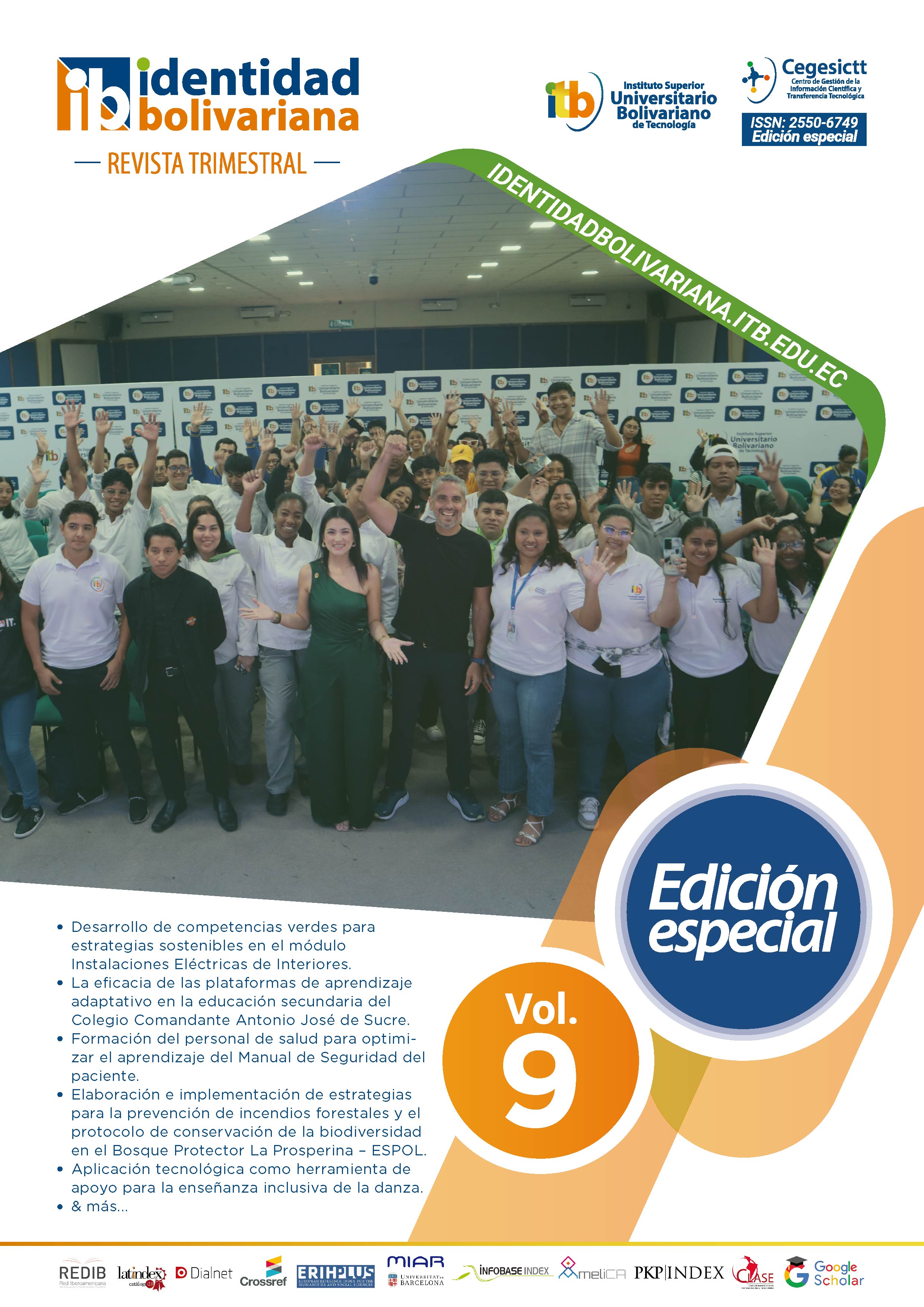The effectiveness of adaptive learning platforms in secondary education at Comandante Antonio José de Sucre High School
Main Article Content
Abstract
Educational digital applications have gained significant prominence
in recent years, and schools cannot remain on the sidelines. Likewise,
touch-screen devices such as smartphones and tablets are increasingly common in family, school, and work environments. Therefore, the aim of this study was to identify the benefits of digital applications in facilitating learning and improving academic performance among
secondary school students. This research was conducted at the Unidad
Educativa Particular Comandante Antonio José de Sucre through a cohort study with final-year secondary school students. The use of a digital application for studying human anatomy was evaluated and compared to a control group that employed conventional study methods. The results showed that the use of digital platforms improved
academic performance by 15.3% compared to traditional methods, with a 100% acceptance rate among students regarding the use of digital applications in their academic training.
Article Details
Section
How to Cite
References
Ávila, E. (2021). Las TIC en las nuevas tendencias educativas. Journal of Latin American Science, 5(2), 318–339. https://doi.org/10.46785/lasjournal.v5i2.82
AlDahdouh, A. A. (2018). Jumping from one resource to another: How do students navigate learning networks? International Journal of Educational Technology in Higher Education, 15(45). https://doi.org/10.1186/s41239-018-0126-x
Aslan Altan, B., & Karalar, H. (2018). How students digitally age: By gaining or losing? İlköğretim Online, 17(3), 738–749. https://doi.org/10.17051/ilkonline.2018.419054
Berns, A., & Reyes Sánchez, S. (2020). A review of virtual reality-based language learning apps. RIED. Revista Iberoamericana de Educación a Distancia, 24(1), 159–177. https://doi.org/10.5944/ried.24.1.27486
Borges, F. (2007). El estudiante de entornos virtuales. Una primera aproximación. Digithum: Revista de los Estudios de Humanidades y los Estudios de Lenguas y Culturas de la UOC, (9), 1–7. http://www.uoc.edu/digithum/9/dt/esp/borges.pdf
Cook, D. A., Levinson, A. J., Garside, S., Dupras, D. M., Erwin, P. J., & Montori, V. M. (2013). Internet-based learning in the health professions: A meta-analysis. JAMA, 300(10), 1181–1196. https://doi.org/10.1001/jama.300.10.1181
Fernández, L. (2019). Las TIC en programas socioeducativos: Evaluación de un entorno virtual como medio de soporte a profesionales en la implementación del programa Caminar en Familia [Tesis doctoral, Universidad de Lleida]. https://www.tdx.cat/bitstream/handle/10803/665034/Tlfr1de1.pdf?sequence=5&isAllowed=y
Jensen, E. P., & McConchie, L. (2020). Brain-based learning: Teaching the way students really learn (3ª ed.). Corwin Press. https://us.corwin.com/en-us/nam/brain-based-learning/book267771
Lugo, M. T., Kelly, V., & Schurmann, S. (2012). Políticas TIC en educación en América Latina: Más allá del modelo 1:1. Campus Virtuales: Revista Científica de Tecnología Educativa, 1(1), 31–42. http://uajournals.com/ojs/index.php/campusvirtuales/article/view/17/16
Mayer, R. E. (2009). Multimedia learning (2ª ed.). Cambridge University Press. https://www.cambridge.org/core/books/multimedia-learning/7A62F072A71289E1E262980CB026A3F9
Moreno, R. (2010). Educational psychology. En P. Peterson, E. Baker, & B. McGaw (Eds.), International encyclopedia of education (3ª ed., pp. 61–68). Elsevier. https://www.sciencedirect.com/referencework/9780080448947/international-encyclopedia-of-education
Pitchford, N. J., Chigeda, A., & Hubber, P. J. (2019). Interactive apps prevent gender discrepancies in early grade mathematics in a low-income country in Sub-Sahara Africa. Developmental Science, 22(5), e12864. https://doi.org/10.1111/desc.12864
Prats, M. Á., Torres-Rodríguez, A., Oberst, U., & Carbonell, X. (2018). Diseño y aplicación de talleres educativos para el uso saludable de internet y redes sociales en la adolescencia: Descripción de un estudio piloto. Pixel-Bit. Revista de Medios y Educación, (52), 111–124. https://doi.org/10.12795/pixelbit.2018.i52.08
Puche, J. (2019). Digital tools to enhance the teaching-learning process of humanities: The case of economic history. Caracteres, 8(2), 129–155. https://n9.cl/7e0ao
Ricoy, M.-C., & Martínez-Carrera, S. (2019). El uso informal del smartphone en adolescentes de centros de protección: Un reto para promover la intervención socioeducativa. Educación XX1, 23(1), 1–21. https://doi.org/10.5944/educXX1.23879
Ricoy, M. C., Martínez Carrera, I., Martínez Carrera, S., & Alonso Carnicero, A. (2022). Posibilidades y controversias de las App en la comunicación y orientación del alumnado de educación secundaria. Estudios Pedagógicos (Valdivia), 48(2), 213–235. https://doi.org/10.4067/S0718-07052022000200213
Ríos Anciani, J. de C. (2020). Uso del smartphone por jóvenes estudiantes de secundaria: Una mirada crítica. Revista Scientific, 5(17), 267–279. https://doi.org/10.29394/scientific.issn.2542-2987.2020.5.17.14.267-279
Torres, J., & Barnabé, T. (2020). Aspectos pedagógicos del conectivismo y su relación con redes sociales y ecologías del aprendizaje. Revista Brasileira de Educação, 25. https://n9.cl/362yi
Vega, O. (2016). De las TIC en la educación a las TIC para la educación. Revista Vector, 11, 24–29. http://vector.ucaldas.edu.co/downloads/Vector11_4.pdf

